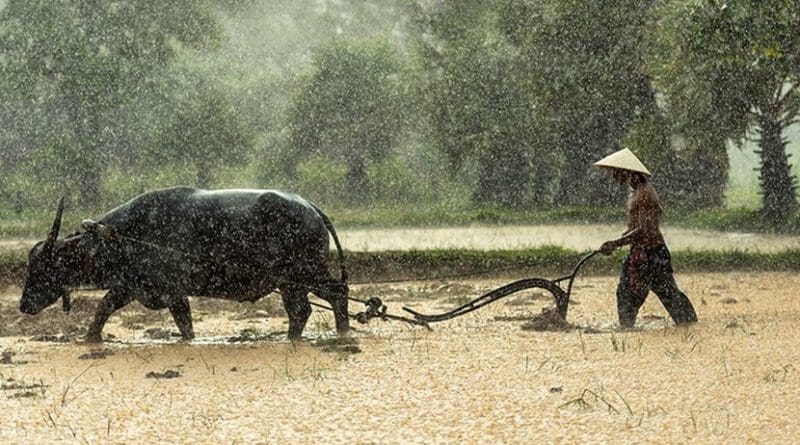China-Myanmar Economic Corridor: Another ‘Hambantota’ In The Making? – Analysis
By SAAG
By Dr. S. Chandrasekharan
In the first week of July, Myanmar formally announced that China and Myanmar have agreed to a 15-point Memorandum of Understanding on building a China-Myanmar Economic Corridor as part of the Belt Road Initiative. Formal signing of the agreement is expected to take place soon.
The Corridor will run from Yunnan Province of China to Mandalay in Central Myanmar, then proceed east towards Yangon and then west to the already established Kyaukphyu Special Economic Zone (SEZ) on the Bay of Bengal.
The two Governments have agreed to collaborate in many sectors that would include basic Infrastructure, Construction, Manufacture, Agriculture, Transport, Finance, Human Resources Development, telecommunications, Research and Technology. This would cover a wide spectrum of most economic and social activities. The real thrust is in developing a geo strategic infrastructure for the Chinese and the rest are mere dressings that will make it acceptable to the public.
The agreement is more of a general one having a large matrix to cover almost everything, but there will be individual working groups and joint working committees on each project thus giving Myanmar a considerable ‘say’ in every project.
There is no doubt that a reluctant Myanmar has been coerced to agree to the concept of a ‘corridor’ under the Belt Road Initiative. Discussions on the economic corridor have been going for quite some time but China started putting pressure from last November that was followed by high level visits of Foreign Minister and the Defence Minister of China who pushed for the corridor with Suu Kyi. The Army would have had no objection as it would not only benefit Army connected companies but the Generals themselves!
Despite its own reservations, Myanmar could not have declined the MOU, as it is dependent on China on managing the ethnic insurgency in the North and the East and for support in the internaltional fora where the Western Countries and the International organizations have ganged up to punish Myanmar on the treatment of Rohingyas.
The New Planning and Finance Minister did confess that Myanmar “cannot sidestep the Belt Road initiative even though they have many views regarding the “debt threat.”
Of particular interest to India, would be the statement of one of the Analysts from China that the Corridor would help for Chinese Goods and Services to flow to India! It is interesting that the Chinese have expressed similar sentiments when they offered to build Railway from Keirung to Rasuva and then to Kathmandu in Nepal. From the Chinese point of view, the BRI in this region cannot be successful without Indian involvement and with two corridors both on the West and the East, the Chinese can wait. It is also interesting to note that Japan which had initially not supported the Belt Road Initiative, is planning to get involved selectively, like some projects in Thailand!
There are many hurdles in the proposed Corridor in Myanmar. It should be understood that China’s initiatives on developing connectivity are not benign as is made out to be.
The biggest worry will be the Kyaukphyu project and the Special Economic Zone to be established by China. In President Thein Sein’s time China managed to repeat the “Hambantota” project of Sri Lanka by claiming 85 percent stake in the project with the Myanmar government providing the rest 15 percent stake and it was agreed to initially. However this came under severe criticism later from the Public that forced the government to re- negotiate the proportionate share for the two countries in the project. The idea from the Myanmar side is to cut down the size of the project so that Myanmar’s stake could be more substantial.
The major thrust of the Corridor is in the infra structure projects that would need large investments. Myanmar does not have the funds and cannot go to other international agencies for funds just as Pakistan is alleged to be trying to finance the BRI initiative. It cannot permit either a pre dominant stake for the Chinese companies which in the long run will be ruinous. The possibility of another Hambantota being repeated cannot be ruled out.
Luckily for Myanmar, unlike earlier days, public awareness has considerably heightened after the advent of democracy. One good example is the abandonment of the multi billion-dollar Myitsone Project in Kachin area because of a public outcry. The project was entirely to produce power for China.
The Corridor will run through major conflict ridden areas of Myanmar in Shan and Kachin territories and it will not be easy to develop this area unless there is stability and peace in the region. While the Government on the one hand is looking for a peaceful solution, the Army has intensified its operations in both Kachin and Shan regions. The Army’s approach and renewed escalation of the conflict in these areas is not for defeating the Kachins but to deny them and then control the resource rich areas in which the army linked companies and Chinese business interests have developed a nexus. The Jade mining region of Hpakant in the Kachin State is one good example.
The challenge for Myanmar is- as one analyst had put it, is that Myanmar can be close to China but cannot be overly dependent on it. This Belt Road initiative with huge investments from China and with near total inability of Myanmar to pay for it, could become another ideal case for making Myanmar a colony of China as it had already happened in Pakistan. The people of Myanmar are aware of it and will not let the Government or the Army to get totally dependent on China.

